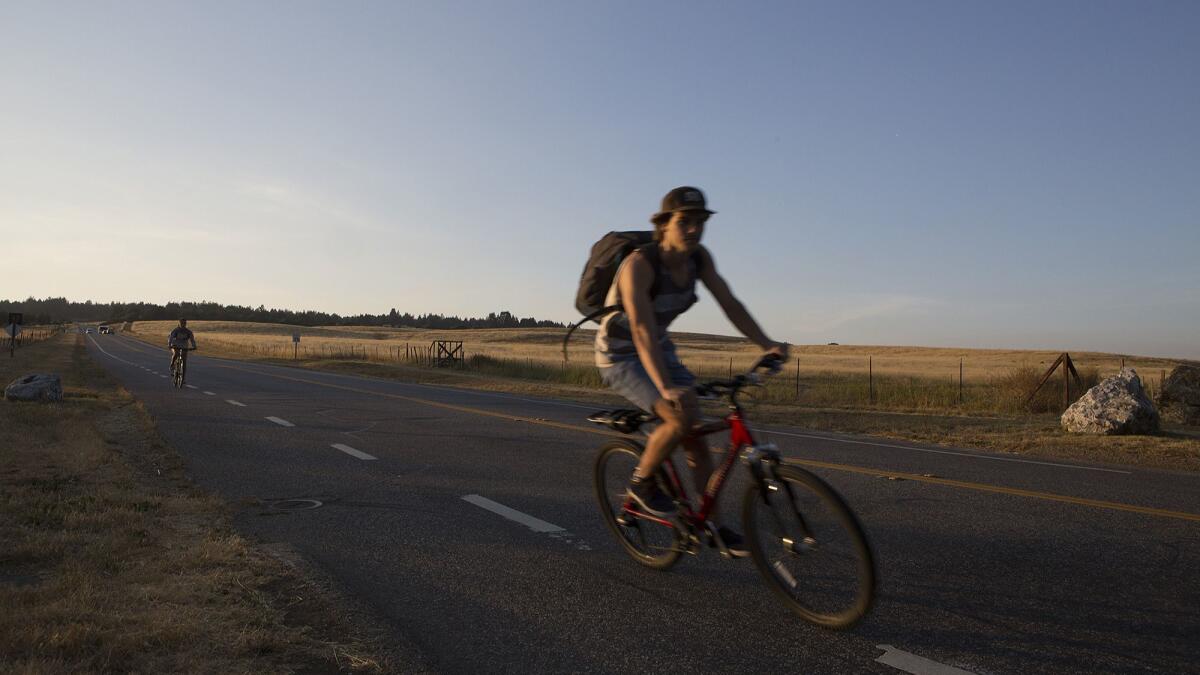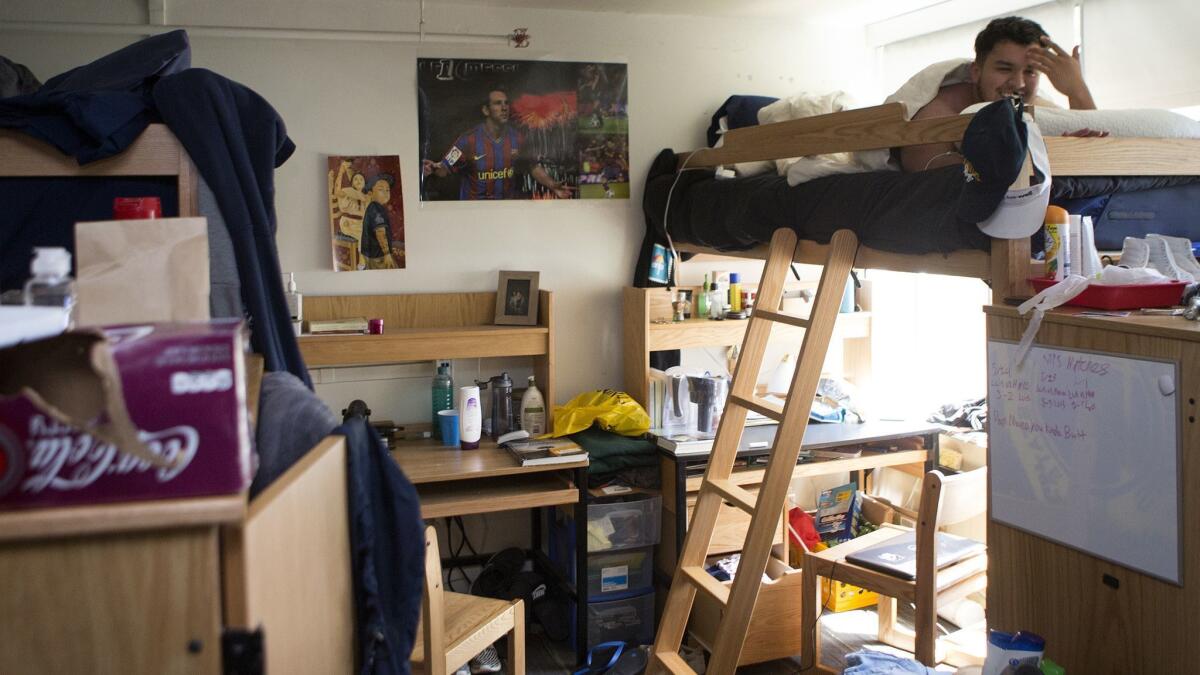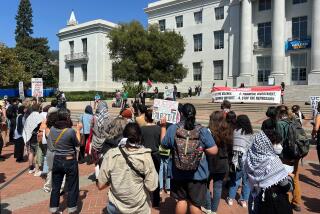At UC Santa Cruz, a housing shortage pits the need for beds against a much-loved meadow

Reporting from Santa Cruz — The road to UC Santa Cruz winds past old lime kilns, assorted barns and storage sheds.
Then a vast meadow opens. Its wild prairie grasses, baked golden on toasty summer days, add a vivid layer of color to the vista of redwood forests beyond and bright blue sky above.
The open space is still. The view it offers is sweeping. Many at Santa Cruz see it is as the iconic gateway to one of the nation’s most breathtaking campuses.
And it’s now at the center of a major campus fight because the university wants to build student housing on it.
In a struggle being fought simultaneously on many University of California campuses, Santa Cruz is finding itself squeezed by state demands to accept thousands more students with limited public funds, a shortage of beds and community protests against growth.
At Santa Cruz, an added complication is the university’s proud tradition of a reverence for nature. Celebrated photographer Ansel Adams helped shape that sensibility five decades ago as campus planners pondered how best to place a university overlooking Monterey Bay, in the middle of rugged knolls, deep ravines and redwood groves.
“Build many trails, reveal many places where a student, or a teacher, or an administrator could sit in a quiet hour with only the redwoods, the grass, the pack-rat nests and the dead twigs intruding upon his solitude,” Adams wrote in 1963, two years before the campus opened.
Meadow supporters who oppose the building plan say they are fighting to preserve that spirit.
At a recent public hearing, Mary Doyle, an alumna and past president of the UC Santa Cruz Foundation, said the meadow “represents beauty and truth in an unconfined, unobstructed environment.” The original designers of the university, she said, deemed it “an invaluable asset to be preserved indefinitely. Their vision represented in many respects the soul of our campus.”
UC Santa Cruz Chancellor George Blumenthal sees it more prosaically.
“It is a nice view. But it isn’t imbued with some mystical character,” he said in an interview. “In fact, what it is is a cow patch.”
He and other campus officials want to use some of that land as part of what would amount to the university’s largest single expansion of housing. It would add 3,000 beds at a cost of $750 million. And it would help ease the crunch of the last five years, as the campus has added more than 2,200 students.

Over that time, as the total campus population has risen to 18,800 — with nearly a third more students than it was designed to hold — dorm lounges became dorm rooms, and dorm rooms squeezed in more and more beds.
The new housing originally was planned for the western side of campus, until the site turned out to include an an area potentially used by the threatened red-legged frog. Buildable space then shrunk to about one-quarter of the original plans.
Designers then proposed splitting the project, leaving 2,920 beds for undergraduates and graduates at the original site. A 140-unit complex for students with families, along with a childcare center, would go on eastern meadow land currently used by farmers to graze their cattle.
The meadow proposal stunned many longtime faculty, alumni and donors, who acknowledged the need for more student housing but said it should be near existing buildings.
More than 70,000 people signed a petition urging Santa Cruz to drop the meadow plan. The chancellor’s advisory board of outside design professionals also voiced opposition. Prominent alumni threatened lawsuits and donor boycotts.
“The injury to the University could be immediate,” the heads of the UC Santa Cruz Foundation and UC Santa Cruz Alumni Assn. wrote in a May letter signed by 42 other leading alumni, faculty, donors and former UC regents.
James Clifford, a professor emeritus who helped start the East Meadow Action Committee to coordinate opposition, said campus administrators failed to fully inform the public about the meadow proposal. Blumenthal denies that but said he extended the public comment period by six weeks to address concerns about transparency.
At the recent public hearings, campus officials presented data that showed alternatives to the meadow plan would be more costly and time-consuming. One option, which would put some beds in the northern forested area of campus, could cost nearly $600 million more because it’s more remote and would need a dining facility and necessary infrastructure. That would drive up student housing fees and construction would take a lot longer, officials said.
Generational, class and racial divides surfaced at the hearings. At one, Thao Le, an Asian American art major, said meadow supporters in the crowd appeared to be “mostly older white folks who probably have homes” and were “a bunch of NIMBYs” arguing about land that was stolen from indigenous tribes in the first place.
Will Hollingsworth, a fourth-year student, yelled: “My friends live in cars! Every day you delay, this is another day they live in cars!”
Some faculty also stressed the need to sacrifice for more housing to attract economically diverse colleagues, staff and students.
“If you can’t live here, what kind of people are you going to recruit?” said chemistry professor Ted Holman. “The wealthy.”
Dan Killam, a doctoral student in earth and planetary science, said his university planning group unanimously embraced the meadow site after ruling out the alternatives.
Concerns about the frog caused the committee to nix one area, which is also used by undergraduates who smoke marijuana there at the annual 420 festival, he said. Another area used by students with trailers is one of the most affordable living spaces on campus.
Building in the forest, meanwhile, would bring out hordes of tree-sitters, Killam said. In 2007, Santa Cruz students launched a 13-month “tree-sit” in an attempt to save 48 redwoods and 11 oak trees slated for removal to make room for a biomedical facility. They ultimately gave up. (One student, Ted Cheung, said his informal Facebook survey of about 30 friends showed twice as many people favored saving trees than the meadow.)
Critics are also unhappy about the use of a nonprofit and a private developer to finance, build and maintain the buildings. But the UC system is moving toward such partnerships in part because the state no longer provides funding for such projects.
Clifford, of the group fighting to preserve the meadow, said accusations of privilege cloud the issue. He said he “pleads guilty” to home ownership but adds that most meadow backers have “good left-wing credentials.” They fully back more student housing — just not in the meadow, he said.
On a recent day, as he surveyed the meadow’s expanse, he noted the birds flying overhead and nature’s palette of gold, green and blue. He said he enjoys the changing vistas — puffy rain clouds casting shadows, bright sun illuminating the wildflowers.
“I feel good not just filling everything up with structure,” he said. “Trees grow back, but fill a meadow and it’s gone forever.”
Chris Connery, a professor of literature, said the meadow was a fitting metaphor for the college experience. “As you drive up to campus, you see a big opening. Your horizons are enlarged. Your vision is expanded.”
Blumenthal and his staff are now sorting through the hundreds of public comments submitted and expect to announce an update this fall. The chancellor said he remains open-minded.
“Maybe somebody will have a suggestion for us,” he said. “But at a certain point, we have students who need housing and we can’t futz around forever in making the decision.”
Twitter: @teresawatanabe
More to Read
Sign up for Essential California
The most important California stories and recommendations in your inbox every morning.
You may occasionally receive promotional content from the Los Angeles Times.











